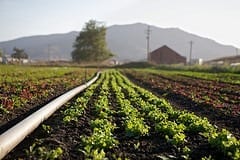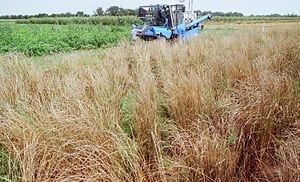
“This is going to help make produce safer”
Researchers from Cornell University have identified some agricultural management practices in the field that can either boost or reduce the risk of contamination in produce from two major foodborne pathogens: salmonella, the biggest single killer among the foodborne microbes, and Listeria monocytogenes. Their findings are published ahead of print in the journal Applied and Environmental Microbiology.
“This is going to help make produce safer,” says Laura Strawn, a researcher on the study. “We could significantly reduce risk of contamination through changes that occur a few days before the harvest.”
Researchers from Cornell University have identified some agricultural management practices in the field that can either boost or reduce the risk of contamination in produce from two major foodborne pathogens: salmonella, the biggest single killer among the foodborne microbes, and Listeria monocytogenes. Their findings are published ahead of print in the journal Applied and Environmental Microbiology.
“This is going to help make produce safer,” says Laura Strawn, a researcher on the study. “We could significantly reduce risk of contamination through changes that occur a few days before the harvest.”
Many of the risk factors were influenced by when they were applied to fields which suggests that adjustments to current practices may reduce the potential for contamination with minimal cost to growers, says Strawn.
Foodborne illness sickens an estimated 9.4 million, and kills around 1,300 annually in the US, according to the Centers for Disease Control and Prevention. Produce accounts for nearly half the illnesses, and 23 percent of the deaths.
“The research is the first to use field collected data to show the association between certain management practices and an increased or decreased likelihood of salmonella and L. monocytogenes,” says Strawn.
For salmonella, manure application within the year prior to the researchers’ sampling boosted the odds of a contaminated field, while the presence of a buffer zone between the fields and potential pathogen reservoirs such as livestock operations or waterways was protective.
Irrigation within three days before sample collection raised the risk of listeria contamination six-fold. Soil cultivation within the week before sampling also increased the chances of contamination.
Go deeper with Bing News on:
Produce-borne Illness
- Researchers target spermidine production to combat emerging drug resistance in Salmonella
Food-borne diseases like typhoid, caused by Salmonella Typhimurium, are a severe threat to public health, especially in India. The indiscriminate use of antibiotics has allowed this bacterium to ...
- New FDA rule requires water testing on produce farms to prevent contamination
The Food and Drug Administration (FDA) has introduced a new food safety rule requiring produce farms to test their water for contamination. This long-awaited rule aims to prevent harmful bacteria from ...
- FDA finally publishes ag-water rule for produce farming operations
After more than a decade of discussion, the Food and Drug Administration has published a final rule for certain agricultural water used in the production ...
- Lyme disease: Unraveling pathogen's tactics could guide vaccine progress
May is Lyme Disease Awareness Month, and despite the prevalence of this disease, there are still many aspects of the infectious cycle that remain unknown ...
- Map Reveals 32 States Where Dog Owners Warned of Common Tick-Borne Disease
Lyme disease is spread through the bites of ticks infected with the Borrelia burgdorferi bacteria. According to PetMD, between 1.4 percent and 13.3 percent of dogs in the U.S. contract the disease.
Go deeper with Google Headlines on:
Produce-borne Illness
[google_news title=”” keyword=”Produce-borne Illness” num_posts=”5″ blurb_length=”0″ show_thumb=”left”]
Go deeper with Bing News on:
Contamination in produce
- Gas, propane stoves produce dangerous levels of nitrogen dioxide, study finds
A new study conducted by researchers from Stanford University’s School of Sustainability found that gas and propane stoves could pose a threat to consumers ...
- Startup develops technology to produce cleaner cement at commercial scale — here's how it could revolutionize construction industry
Planet-overheating pollution from cement manufacturing is "an existential ... Startup develops technology to produce cleaner cement at commercial scale — here's how it could revolutionize construction ...
- Plastic pollution treaty talks hit critical stage
The Nature Conservancy, Greenpeace and other environmental advocates believe the treaty must reduce the amount of plastic that is produced and used in order to end plastic pollution. “We’re more than ...
- Catch up on the day’s stories: ‘Ozempic babies,’ pollution-sucking vacuum, music with a message
👋 Welcome to 5 Things PM! A giant pollution-sucking vacuum just started operating in Iceland. The direct air capture plant, dubbed “Mammoth,” takes in air and uses chemicals to strip out the carbon.
- New FDA rule requires water testing on produce farms to prevent contamination
The Food and Drug Administration (FDA) has introduced a new food safety rule requiring produce farms to test their water for contamination. This long-awaited rule aims to prevent harmful bacteria from ...
Go deeper with Google Headlines on:
Contamination in produce
[google_news title=”” keyword=”contamination in produce” num_posts=”5″ blurb_length=”0″ show_thumb=”left”]










